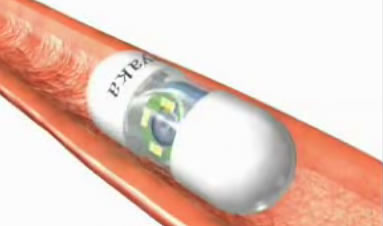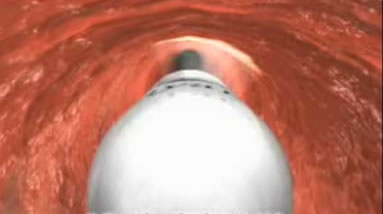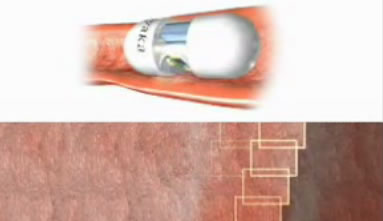Science Fiction
Dictionary
A B C D E F G H I J K L M N O P Q R S T U V W X Y Z
Disco Capsule Endoscope Theme Park Video

Capsule endoscopes have been around since the late 1990's. The basic idea is that you swallow a tiny camera that takes pictures of your intestinal tract as it is pushed through by peristalsis (the muscular contractions that move food along). A physician reviews the pictures and saves you the effort of getting a full colonoscopy.
The video attached below is an entirely different kettle of fish altogether. Part promotion, part meticulous engineering diagram, part spacey consciousness-expanding overflight, part disco, part theme park (no, really!), this entirely serious informational video must be seen (and heard) to be believed.
(Sayaka capsule endoscope video)
In fact, as far as I know, all of these features have been duplicated by other capsule endoscopes, notably the one by Olympus. But they don't have cool videos, do they?
The Sayaka capsule endoscope has a camera that spins around within the capsule, photographing one small section of the intestinal wall at a time.

(The Sayaka capsule endoscope's rotating camera)
The camera provides its own little flash, as well, providing intermittent lighting (or disco strobe!) during its eight-meter journey, which can last up to eight hours.

(Great view from behind capsule showing flash)
As many as 870,000 pictures are transmitted outside the body to a receiving unit. The software application that goes with the camera then stitches together the pictures into a smooth mosaic representing the inner surface of the intestinal tract.

(The Sayaka capsule endoscope creates an intestinal wall mosaic)
You're probably wondering about the theme park. Well, if the Disney people who made the rides at Epcot's Wonders of Life pavilion ever get a hold of this video (and maybe sponsorship by Sayaka, Olympus or one of the other companies), that ride is a done deal. I can hear that music now as my little four-person capsule is pushed gently along the track...
Via Pink Tentacle.
Scroll down for more stories in the same category. (Story submitted 1/5/2007)
Follow this kind of news @Technovelgy.| Email | RSS | Blog It | Stumble | del.icio.us | Digg | Reddit |
Would
you like to contribute a story tip?
It's easy:
Get the URL of the story, and the related sf author, and add
it here.
Comment/Join discussion ( 0 )
Related News Stories - (" Medical ")
Bone-Building Drug Evenity Approved
'Compounds devised by the biochemists for the rapid building of bone...' - Edmond Hamilton, 1932.
BrainBridge Concept Transplant Of Human Head Proposed
'Briquet’s head seemed to think that to find and attach a new body to her head was as easy as to fit and sew a new dress.' - Alexander Belaev (1925)
Natural Gait With Prosthetic Connected To Nervous System
'The leg was to function, in a way, as a servo-mechanism operated by Larry’s brain...' - Charles Recour, 1949.
Brain Implant Is Able To Capture Your Inner Dialogue
'So you see, you can hide nothing from me.'
Technovelgy (that's tech-novel-gee!) is devoted to the creative science inventions and ideas of sf authors. Look for the Invention Category that interests you, the Glossary, the Invention Timeline, or see what's New.
Science Fiction
Timeline
1600-1899
1900-1939
1940's 1950's
1960's 1970's
1980's 1990's
2000's 2010's
Current News
Boring Company Vegas Loop Like Asimov Said
'There was a wall ahead... It was riddled with holes that were the mouths of tunnels.'
Rigid Metallic Clothing From Science Fiction To You
'...support the interior human structure against Jupiter’s pull.'
Is The Seattle Ultrasonics C-200 A Heinlein Vibroblade?
'It ain't a vibroblade. It's steel. Messy.'
Roborock Saros Z70 Is A Robot Vacuum With An Arm
'Anything larger than a BB shot it picked up and placed in a tray...'
A Beautiful Visualization Of Compact Food
'The German chemists have discovered how to supply the needed elements in compact, undiluted form...'
Bone-Building Drug Evenity Approved
'Compounds devised by the biochemists for the rapid building of bone...'
Secret Kill Switch Found In Yutong Buses
'The car faltered as the external command came to brake...'
Inmotion Electric Unicycle In Combat
'It is about the size and shape of a kitchen stool, gyro-stabilized...'
Grok Scores Best In Psychological Tests
'Try to find out how he ticks...'
PaXini Supersensitive Robot Fingers
'My fingers are not that sensitive...'
Congress Considers Automatic Emergency Braking, One Hundred Years Too Late
'The greatest problem of all was the elimination of the human element of braking together with its inevitable time lag.'
The Desert Ship Sailed In Imagination
'Across the ancient sea floor a dozen tall, blue-sailed Martian sand ships floated, like blue smoke.'
The Zapata Air Scooter Would Be Great In A Science Fiction Story
'Betty's slapdash style.'
Thermostabilized Wet Meat Product (NASA Prototype)
There are no orbiting Michelin stars. Yet.
Could Crystal Batteries Generate Power For Centuries?
'Power could be compressed thus into an inch-square cube of what looked like blue-white ice'
India Ponders Always-On Smartphone Location Tracking
'It is necessary... for your own protection.'
